小升初专题复习 代词+名词 复习课件(共16张PPT)
文档属性
| 名称 | 小升初专题复习 代词+名词 复习课件(共16张PPT) | 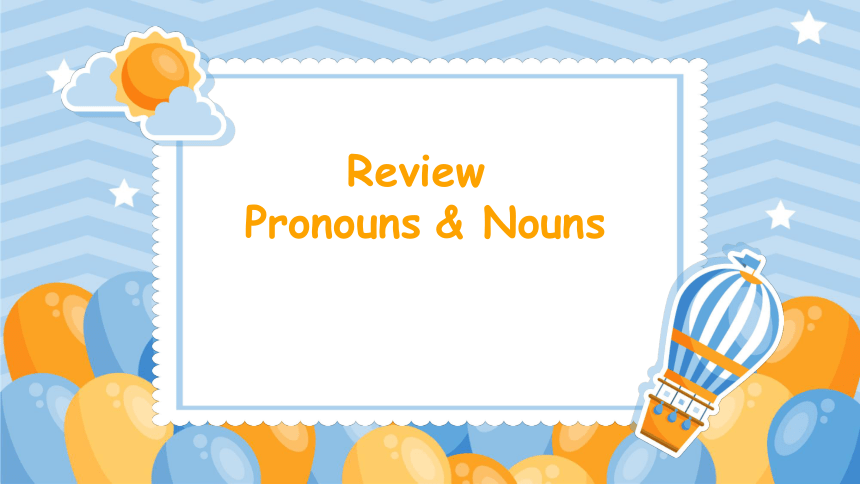 | |
| 格式 | pptx | ||
| 文件大小 | 2.8MB | ||
| 资源类型 | 教案 | ||
| 版本资源 | 通用版 | ||
| 科目 | 英语 | ||
| 更新时间 | 2023-10-07 20:53:08 | ||
图片预览

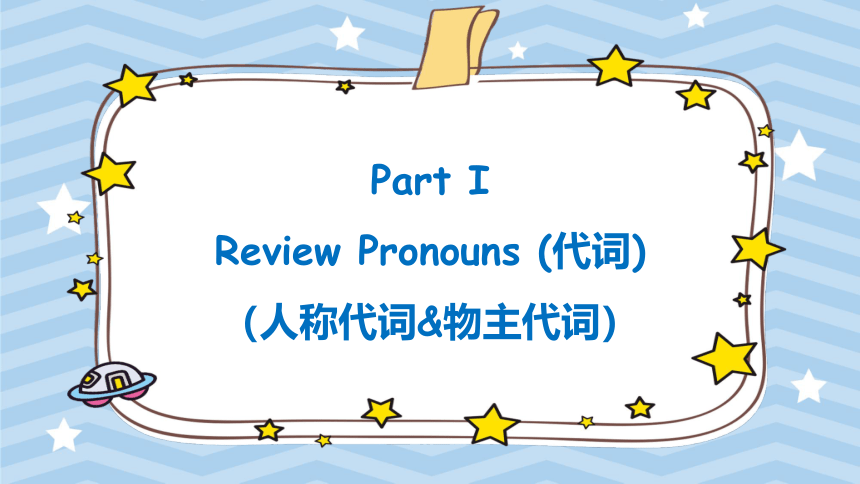
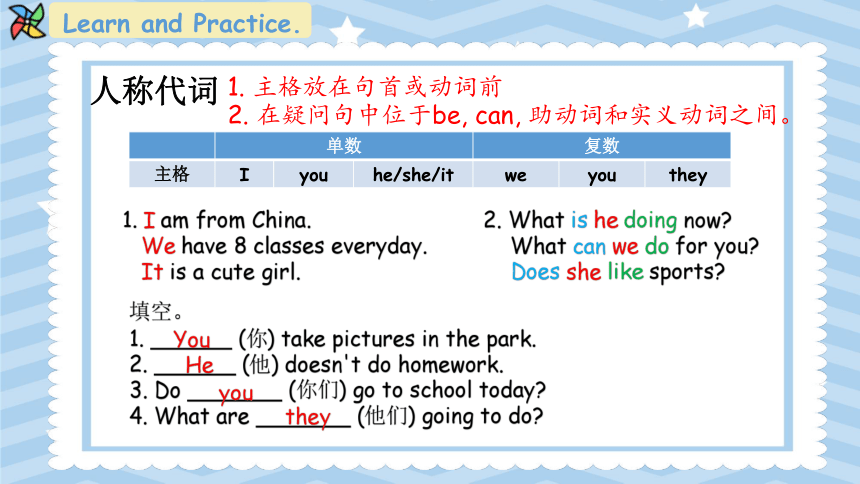
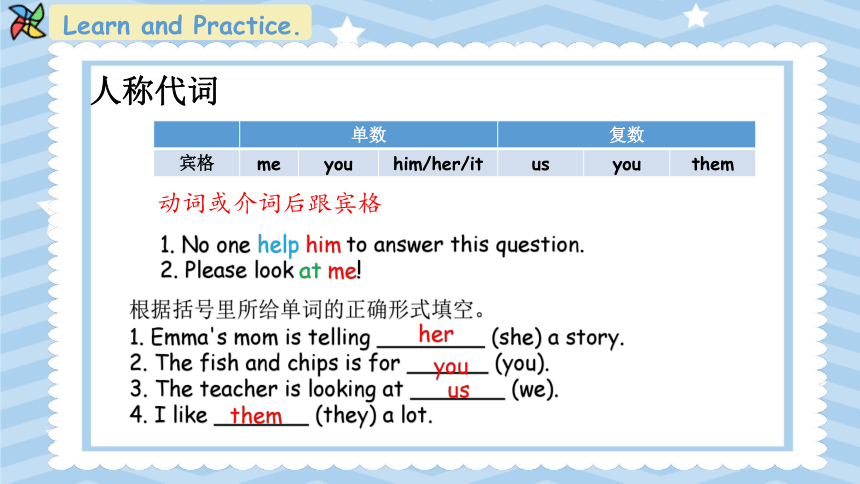
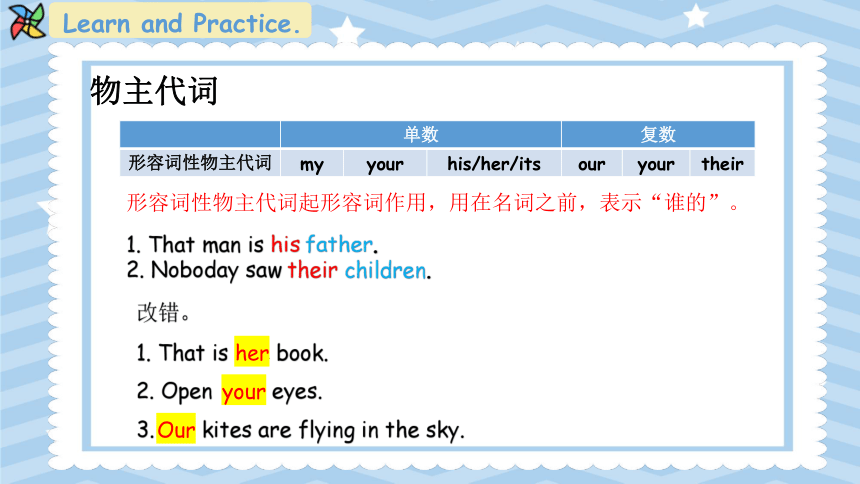
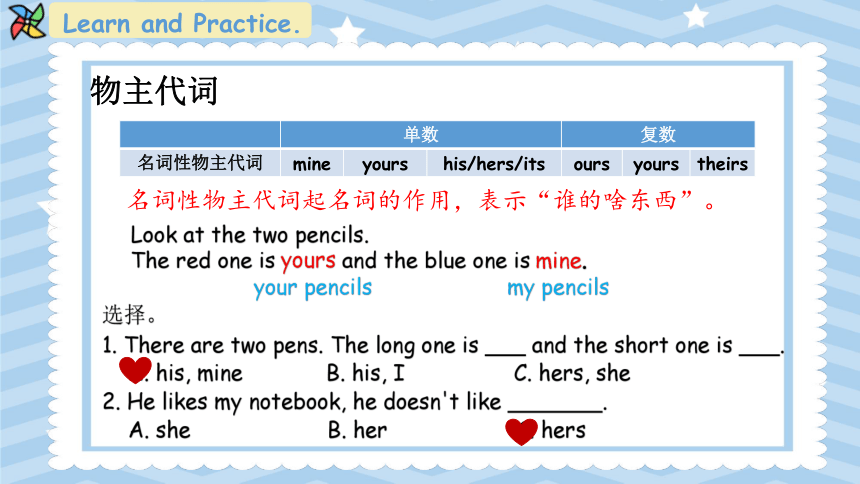
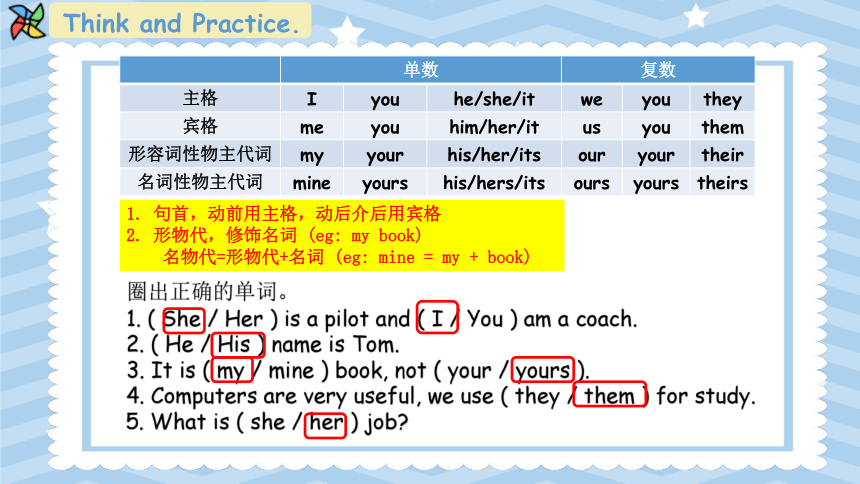
文档简介
(共16张PPT)
Review
Pronouns & Nouns
Part I
Review Pronouns (代词)
(人称代词&物主代词)
人称代词
1. 主格放在句首或动词前
2. 在疑问句中位于be, can, 助动词和实义动词之间。
Learn and Practice.
单数 复数 主格 I you he/she/it we you they
1. I am from China. 2. What is he doing now
We have 8 classes everyday. What can we do for you
It is a cute girl. Does she like sports
填空。
1. ______ (你) take pictures in the park.
2. ______ (他) doesn't do homework.
3. Do _______ (你们) go to school today
4. What are _______ (他们) going to do
You
He
you
they
人称代词
动词或介词后跟宾格
单数 复数 宾格 me you him/her/it us you them
1. No one help him to answer this question.
2. Please look at me!
Learn and Practice.
根据括号里所给单词的正确形式填空。
1. Emma's mom is telling ________ (she) a story.
2. The fish and chips is for ______ (you).
3. The teacher is looking at _______ (we).
4. I like _______ (they) a lot.
her
you
us
them
物主代词
形容词性物主代词起形容词作用,用在名词之前,表示“谁的”。
单数 复数 形容词性物主代词 my your his/her/its our your their
1. That man is his father.
2. Noboday saw their children.
Learn and Practice.
改错。
1. That is she book.
2. Open you eyes.
3. We kites are flying in the sky.
her
your
Our
物主代词
名词性物主代词起名词的作用,表示“谁的啥东西”。
单数 复数 名词性物主代词 mine yours his/hers/its ours yours theirs
Look at the two pencils.
The red one is yours and the blue one is mine.
your pencils my pencils
Learn and Practice.
选择。
1. There are two pens. The long one is ___ and the short one is ___.
A. his, mine B. his, I C. hers, she
2. He likes my notebook, he doesn't like _______.
A. she B. her C. hers
单数 复数 主格 I you he/she/it we you they
宾格 me you him/her/it us you them
形容词性物主代词 my your his/her/its our your their
名词性物主代词 mine yours his/hers/its ours yours theirs
1. 句首,动前用主格,动后介后用宾格
2. 形物代,修饰名词 (eg: my book)
名物代=形物代+名词 (eg: mine = my + book)
Think and Practice.
圈出正确的单词。
1. ( She / Her ) is a pilot and ( I / You ) am a coach.
2. ( He / His ) name is Tom.
3. It is ( my / mine ) book, not ( your / yours ).
4. Computers are very useful, we use ( they / them ) for study.
5. What is ( she / her ) job
1. 句首,动前用主格,动后介后用宾格
2. 形物代,修饰名词 (eg: my book)
名物代=形物代+名词 (eg: mine = my + book)
Think and Practice.
A: Could you help _______ (我们) please
B: What's wrong
A: __________ car is broken.
B: Which one is ____________
A: The blue one is ___________.
B: Ok! I can help __________.
A: Thank you.
us
Our
yours
ours
you
Part II
Review Nouns (名词)
表示人、事、物、地点或抽象概念的统一名称。
Learn and Practice.
专有名词 & 普通名词
1. 专有名词:表示具体的人,事物,地点,团体或机构的专有名称(第一个字母大写),
(Emma, the Great Wall, China, the Greens)
2. 普通名词:
a. 个体名词:单个的人和事物。(car, photo)
b. 集体名词:一群人或一些事物的名称。(family, government)
c. 复合名词:两个或两个以上名词连在一起构成的名词。(passer-by)
d. 物质名词:物质或不具备确定形状和大小的个体的物质。(air, water)
e. 抽象名词:动作,状态,品质或其它抽象概念。(life, friendship)
填空。
1. I love my city, _______ (西安).
2. She is a _______ (女孩).
4. There are three ________ (人) in my family.
4. I like drinking ________ (牛奶).
5. I studied food pyramid in my ________ (健康) class.
girl
people
milk
health
Xi'an
Learn and Practice.
可数名词 & 不可数名词
1. 不可数名词:是指不能以数目来计算,没有复数形式,只有单数形式,前面不能用
不定冠词a / an。
物质名词(无法分为个体) air, bread, butter, cake, cheese, coffee, tea, meat, rice, water, milk, hair, ice, grass, gold...
抽象名词(动作,状态,品质等) work, homework, time, knowledge...
学科 English, Chinese, maths, music...
运动和休闲 football, basketball, dancing, traveling, opera...
填空。
1. I like drinking coffees.
2. It is times to play.
3. My favourite subject is art.
4. I am good at playing footballs.
coffee
time
football
√
Learn and Practice.
可数名词 & 不可数名词
1. 不可数名词:如果表示不可数名词的具体数量,其前面必须用“计量名词+of“ 短语,
但是计量名词有单、复数之分。
a piece of paper - three pieces of paper
a bottle of water - five bottles of water
a glass of milk - two glasses of milk
a cup of tea - four cups of tea...
填空。
1. I would like three ________ (glass) of ________ (water).
2. Could you give me two _______ (cup) of _______ (coffee)
3. I want five _______ (piece) of ________ (paper).
glasses water
cups coffee
pieces paper
Learn and Know.
可数名词 & 不可数名词
2. 可数名词:能以数目来计算,有复数形式。
一般的名词词尾直接 s car-cars, book-books
以s, x, ch, sh结尾,在词尾 es bus-buses, box-boxes,
watch-watched, brush-brushed
以"辅音字母+y"结尾,将y变i es 以"元音字母+y"结尾的名词,直接 s city-cities, family-families
boy-boys, day-days
以o结尾的名词, 通常有生命的 es,无生命的 s hero-heroes, potato-potatoes, tomato-tomatoes
piano-pianos, radio-radios, photo-photos
以f 或fe 结尾的名词,将f或fe变v es leaf-leaves, wolf-wolves
knife-knives, wife-wives
单复同形 fish, sheep, deer, cattle
不规则变化 man-men, woman-women
goose, geese, foot-feet, tooth-teeth
mouse-mice, child-children
Think and Practice.
1. 一般的名词词尾直接 s
2. 以s, x, ch, sh结尾,在词尾 es
3. 以"辅音字母+y"结尾,将y变i es;以"元音字母+y"结尾的名词,直接 s
4.以o结尾的名词,通常有生命的 es,无生命的 s
5. 以f 或fe 结尾的名词,将f或fe变v es
根据括号里所给单词的正确形式填空。
1. There are 5 _______ (bus) and 10 ________ (car) on the road.
2. I went to many _______ (city) and I enjoyed my ______ (day) there.
3. I can see some __________ (tomato) in the box and four ________
(photo) on the wall.
4. The policeman caught two _________ (thief) yesterday. They had
_______ (knife) in their hands.
5. There are many __________ (child) and ________ (woman) in the park.
They are looking at some _________ (goose).
buses
cars
cities
days
tomatoes
photos
thieves
knives
children
women
geese
Learn and Practice.
单数变复数:
1. this - that 2. these - those
3. you - you 4. he/she/it -they
5. I - we 6. am/is - are
请将句子单数变复数。
1. This is a book. __________________________
2. That is a girl. __________________________
3. I am a students. __________________________
4. It is a black watch. __________________________
5. What is this __________________________
These are books.
Those are girls.
We are students.
They are black watches.
What are these
THANK YOU!
Review
Pronouns & Nouns
Part I
Review Pronouns (代词)
(人称代词&物主代词)
人称代词
1. 主格放在句首或动词前
2. 在疑问句中位于be, can, 助动词和实义动词之间。
Learn and Practice.
单数 复数 主格 I you he/she/it we you they
1. I am from China. 2. What is he doing now
We have 8 classes everyday. What can we do for you
It is a cute girl. Does she like sports
填空。
1. ______ (你) take pictures in the park.
2. ______ (他) doesn't do homework.
3. Do _______ (你们) go to school today
4. What are _______ (他们) going to do
You
He
you
they
人称代词
动词或介词后跟宾格
单数 复数 宾格 me you him/her/it us you them
1. No one help him to answer this question.
2. Please look at me!
Learn and Practice.
根据括号里所给单词的正确形式填空。
1. Emma's mom is telling ________ (she) a story.
2. The fish and chips is for ______ (you).
3. The teacher is looking at _______ (we).
4. I like _______ (they) a lot.
her
you
us
them
物主代词
形容词性物主代词起形容词作用,用在名词之前,表示“谁的”。
单数 复数 形容词性物主代词 my your his/her/its our your their
1. That man is his father.
2. Noboday saw their children.
Learn and Practice.
改错。
1. That is she book.
2. Open you eyes.
3. We kites are flying in the sky.
her
your
Our
物主代词
名词性物主代词起名词的作用,表示“谁的啥东西”。
单数 复数 名词性物主代词 mine yours his/hers/its ours yours theirs
Look at the two pencils.
The red one is yours and the blue one is mine.
your pencils my pencils
Learn and Practice.
选择。
1. There are two pens. The long one is ___ and the short one is ___.
A. his, mine B. his, I C. hers, she
2. He likes my notebook, he doesn't like _______.
A. she B. her C. hers
单数 复数 主格 I you he/she/it we you they
宾格 me you him/her/it us you them
形容词性物主代词 my your his/her/its our your their
名词性物主代词 mine yours his/hers/its ours yours theirs
1. 句首,动前用主格,动后介后用宾格
2. 形物代,修饰名词 (eg: my book)
名物代=形物代+名词 (eg: mine = my + book)
Think and Practice.
圈出正确的单词。
1. ( She / Her ) is a pilot and ( I / You ) am a coach.
2. ( He / His ) name is Tom.
3. It is ( my / mine ) book, not ( your / yours ).
4. Computers are very useful, we use ( they / them ) for study.
5. What is ( she / her ) job
1. 句首,动前用主格,动后介后用宾格
2. 形物代,修饰名词 (eg: my book)
名物代=形物代+名词 (eg: mine = my + book)
Think and Practice.
A: Could you help _______ (我们) please
B: What's wrong
A: __________ car is broken.
B: Which one is ____________
A: The blue one is ___________.
B: Ok! I can help __________.
A: Thank you.
us
Our
yours
ours
you
Part II
Review Nouns (名词)
表示人、事、物、地点或抽象概念的统一名称。
Learn and Practice.
专有名词 & 普通名词
1. 专有名词:表示具体的人,事物,地点,团体或机构的专有名称(第一个字母大写),
(Emma, the Great Wall, China, the Greens)
2. 普通名词:
a. 个体名词:单个的人和事物。(car, photo)
b. 集体名词:一群人或一些事物的名称。(family, government)
c. 复合名词:两个或两个以上名词连在一起构成的名词。(passer-by)
d. 物质名词:物质或不具备确定形状和大小的个体的物质。(air, water)
e. 抽象名词:动作,状态,品质或其它抽象概念。(life, friendship)
填空。
1. I love my city, _______ (西安).
2. She is a _______ (女孩).
4. There are three ________ (人) in my family.
4. I like drinking ________ (牛奶).
5. I studied food pyramid in my ________ (健康) class.
girl
people
milk
health
Xi'an
Learn and Practice.
可数名词 & 不可数名词
1. 不可数名词:是指不能以数目来计算,没有复数形式,只有单数形式,前面不能用
不定冠词a / an。
物质名词(无法分为个体) air, bread, butter, cake, cheese, coffee, tea, meat, rice, water, milk, hair, ice, grass, gold...
抽象名词(动作,状态,品质等) work, homework, time, knowledge...
学科 English, Chinese, maths, music...
运动和休闲 football, basketball, dancing, traveling, opera...
填空。
1. I like drinking coffees.
2. It is times to play.
3. My favourite subject is art.
4. I am good at playing footballs.
coffee
time
football
√
Learn and Practice.
可数名词 & 不可数名词
1. 不可数名词:如果表示不可数名词的具体数量,其前面必须用“计量名词+of“ 短语,
但是计量名词有单、复数之分。
a piece of paper - three pieces of paper
a bottle of water - five bottles of water
a glass of milk - two glasses of milk
a cup of tea - four cups of tea...
填空。
1. I would like three ________ (glass) of ________ (water).
2. Could you give me two _______ (cup) of _______ (coffee)
3. I want five _______ (piece) of ________ (paper).
glasses water
cups coffee
pieces paper
Learn and Know.
可数名词 & 不可数名词
2. 可数名词:能以数目来计算,有复数形式。
一般的名词词尾直接 s car-cars, book-books
以s, x, ch, sh结尾,在词尾 es bus-buses, box-boxes,
watch-watched, brush-brushed
以"辅音字母+y"结尾,将y变i es 以"元音字母+y"结尾的名词,直接 s city-cities, family-families
boy-boys, day-days
以o结尾的名词, 通常有生命的 es,无生命的 s hero-heroes, potato-potatoes, tomato-tomatoes
piano-pianos, radio-radios, photo-photos
以f 或fe 结尾的名词,将f或fe变v es leaf-leaves, wolf-wolves
knife-knives, wife-wives
单复同形 fish, sheep, deer, cattle
不规则变化 man-men, woman-women
goose, geese, foot-feet, tooth-teeth
mouse-mice, child-children
Think and Practice.
1. 一般的名词词尾直接 s
2. 以s, x, ch, sh结尾,在词尾 es
3. 以"辅音字母+y"结尾,将y变i es;以"元音字母+y"结尾的名词,直接 s
4.以o结尾的名词,通常有生命的 es,无生命的 s
5. 以f 或fe 结尾的名词,将f或fe变v es
根据括号里所给单词的正确形式填空。
1. There are 5 _______ (bus) and 10 ________ (car) on the road.
2. I went to many _______ (city) and I enjoyed my ______ (day) there.
3. I can see some __________ (tomato) in the box and four ________
(photo) on the wall.
4. The policeman caught two _________ (thief) yesterday. They had
_______ (knife) in their hands.
5. There are many __________ (child) and ________ (woman) in the park.
They are looking at some _________ (goose).
buses
cars
cities
days
tomatoes
photos
thieves
knives
children
women
geese
Learn and Practice.
单数变复数:
1. this - that 2. these - those
3. you - you 4. he/she/it -they
5. I - we 6. am/is - are
请将句子单数变复数。
1. This is a book. __________________________
2. That is a girl. __________________________
3. I am a students. __________________________
4. It is a black watch. __________________________
5. What is this __________________________
These are books.
Those are girls.
We are students.
They are black watches.
What are these
THANK YOU!
